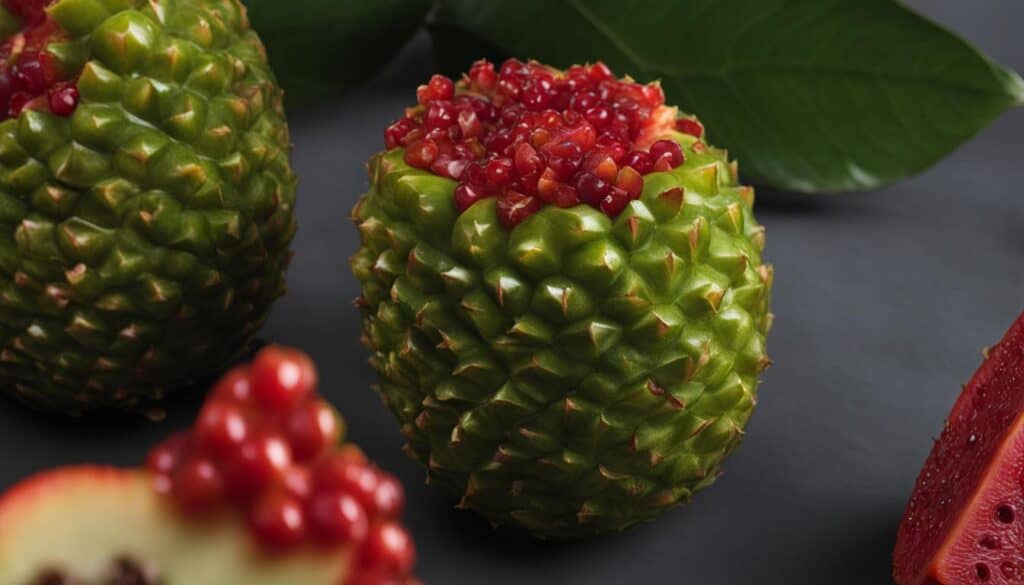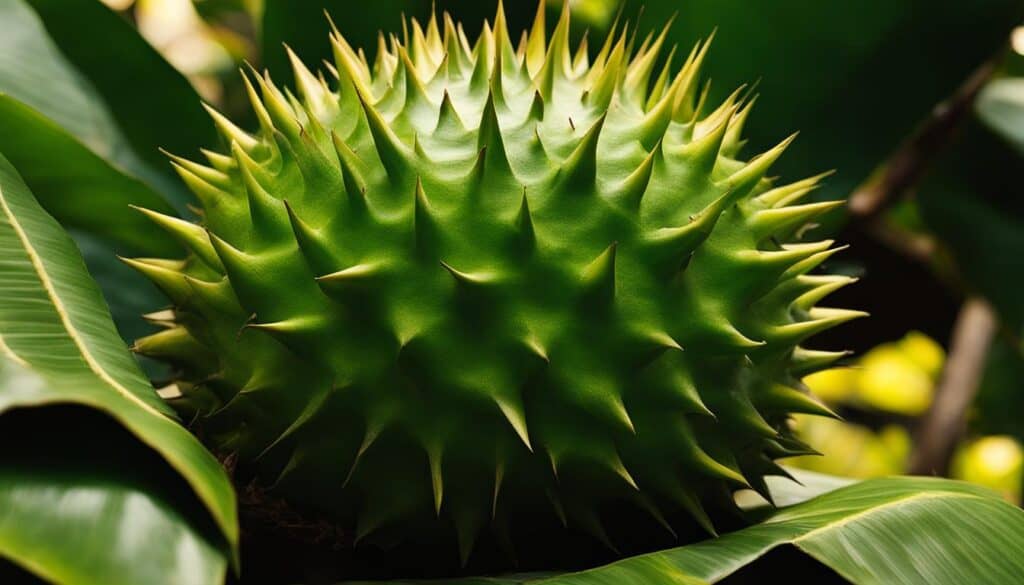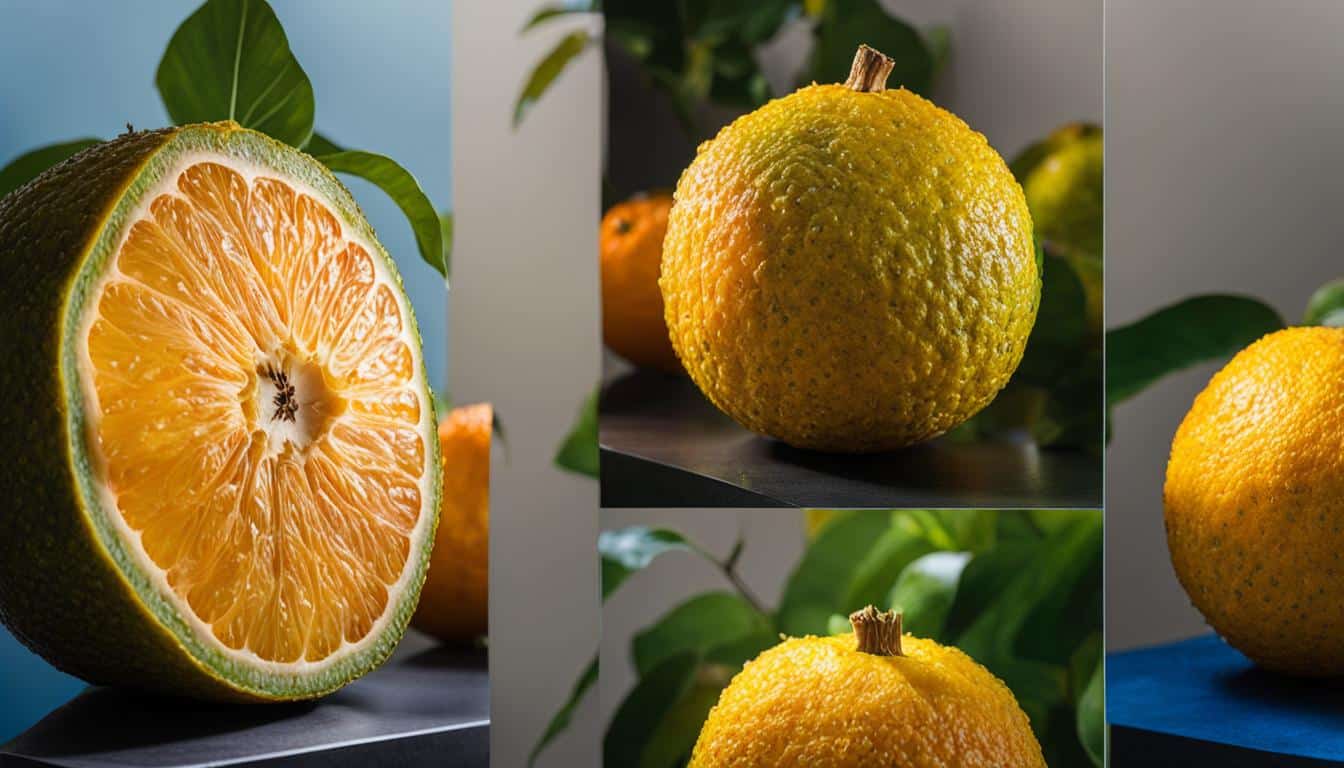The search for a fruit or vegetable that starts with the letter U can lead us to discover some unique and underrated gems. From the ugli fruit, urad dal, and ugu vegetable to the upo squash, ugni fruit, uva ursi, and ulu fruit, there are several intriguing options to explore.
Key Takeaways:
- The ugli fruit is a citrus fruit that is a cross between a grapefruit, an orange, and a tangerine.
- Urad dal, also known as black gram, is a protein-packed legume commonly used in Indian cuisine.
- The ugu vegetable, also known as fluted pumpkin, is a popular vegetable in Nigerian cuisine.
- Upo squash, also known as bottle gourd, is a versatile gourd commonly used in Asian and Mediterranean cuisines.
- The ugni fruit, also known as Chilean guava or strawberry myrtle, is a sweet and tart treat.
Ugli Fruit – A Citrus Dream
The ugli fruit, with its peculiar name, is an intriguing citrus fruit that is a cross between a grapefruit, an orange, and a tangerine. Its appearance may not be the most appealing, with a rough and wrinkled skin, but don’t let that deceive you. The ugli fruit offers a delightful combination of sweetness and tanginess that is sure to tantalize your taste buds.
Not only is the ugli fruit a treat for your palate, but it also packs a nutritional punch. Rich in vitamin C and other antioxidants, this citrus dream is a great addition to your diet. Vitamin C is known for its immune-boosting properties and its ability to promote collagen production for healthy skin. The antioxidants found in ugli fruit can help combat oxidative stress and reduce the risk of chronic diseases.
There are various ways to enjoy the ugli fruit. Many people prefer to eat it fresh, peeling away the rough skin to reveal the juicy flesh inside. Its tanginess makes it a popular choice for fruit salads and refreshing juices. If you’re feeling adventurous, you can also incorporate ugli fruit into your favorite citrus-based desserts, such as pies or sorbets. With its unique flavor profile and nutritional benefits, the ugli fruit is a citrus dream worth exploring.
Did You Know?
In 1924, the ugli fruit was discovered in Jamaica by a citrus farmer named Rev. Wentworth Baker. Its name, ugli, is derived from the fruit’s unsightly appearance, with its rough and uneven skin. However, despite its unattractive exterior, the ugli fruit has gained popularity for its delicious taste and nutritional value. So don’t judge a fruit by its cover!
Urad Dal – A Protein-Packed Legume
When it comes to protein-rich foods, urad dal is a standout legume. Also known as black gram, urad dal is a popular ingredient in Indian cuisine. It not only adds a rich flavor to dishes but also provides a wealth of nutritional benefits.
Urad dal is an excellent source of protein, making it a great choice for vegetarians and vegans looking to meet their protein needs. The legume is also high in dietary fiber, which aids digestion and helps maintain a healthy digestive system.
In addition to protein and fiber, urad dal is rich in various vitamins and minerals, including iron, magnesium, and potassium. These nutrients play a crucial role in promoting overall health and well-being.
Urad Dal Recipes:
- Urad dal soup
- Urad dal curry
- Urad dal dosa
- Urad dal khichdi
These are just a few examples of the many delicious ways you can incorporate urad dal into your diet. Whether you’re looking for a comforting soup, a flavorful curry, or a crispy dosa, urad dal offers a versatile and nutritious option.

| Nutrient | Amount per 100g |
|---|---|
| Protein | 24g |
| Dietary Fiber | 14g |
| Iron | 7.57mg |
| Magnesium | 189mg |
| Potassium | 983mg |
As you can see, urad dal is a nutritional powerhouse, packed with protein, fiber, and essential vitamins and minerals. So why not give it a try and add this delicious legume to your next meal?
Ugu Vegetable – A Nigerian Delight
The ugu vegetable, also known as fluted pumpkin, is a popular and highly nutritious vegetable in Nigerian cuisine. It is cultivated mainly for its leaves, which are rich in vitamins A, C, and E, calcium, and iron. With its slightly bitter taste and unique texture, ugu vegetable adds a delightful flavor and vibrant color to a variety of dishes.
In Nigerian cuisine, ugu vegetable is often used in soups and stews, such as the famous Egusi soup. Its leaves are usually shredded or finely chopped and added to the dish to enhance its nutritional value. The vegetable is also a key ingredient in a popular Igbo dish called Ofe Owerri, a thick and hearty soup made with assorted meats and vegetables.
Not only is ugu vegetable delicious, but it also offers numerous health benefits. Its high vitamin content helps boost the immune system and improve overall well-being. Additionally, the calcium and iron in ugu vegetable contribute to healthy bones and prevent iron deficiency anemia. Including ugu vegetable in your diet can be a great way to add flavor, nutrients, and color to your meals.
Health Benefits of Ugu Vegetable:
- Rich in vitamins A, C, and E
- Good source of calcium and iron
- Boosts the immune system
- Promotes healthy bones
- Prevents iron deficiency anemia
Popular Nigerian Dishes Featuring Ugu Vegetable:
- Egusi Soup
- Ofe Owerri
- Afang Soup
- Edikang Ikong
Whether you’re a fan of Nigerian cuisine or simply looking to explore new flavors, ugu vegetable is definitely worth a try. Its unique taste and nutritional benefits make it a standout ingredient in the culinary world. So, why not incorporate ugu vegetable into your next meal and savor the deliciousness it brings to the table?
Upo Squash – A Versatile Gourd
The upo squash, also known as bottle gourd, is a versatile gourd that offers a wide range of culinary possibilities. Its mild flavor and spongy texture make it ideal for various cooking methods, allowing it to absorb flavors and complement a variety of dishes.
One popular way to prepare upo squash is by stir-frying it with other vegetables and proteins, creating a colorful and nutritious meal. Its mild flavor blends well with different seasonings and spices, making it a versatile ingredient that can be adapted to various cuisines.
“The upo squash’s spongy texture allows it to absorb the flavors of the dish, resulting in a delicious and satisfying meal.”
Another way to enjoy upo squash is by steaming it, which helps retain its natural moisture and nutrients. Steamed upo squash can be served as a side dish or incorporated into salads, adding a refreshing and light element to the meal.
For those looking to get creative in the kitchen, upo squash can also be hollowed out and stuffed with a mixture of meats, vegetables, and spices. Once baked, the upo squash becomes a delicious and filling main course that is sure to impress.
| Cooking Methods | Advantages |
|---|---|
| Stir-frying | Allows flavors to meld together |
| Steaming | Retains natural moisture and nutrients |
| Stuffing and baking | Creates a flavorful and filling dish |
Whether you’re a seasoned cook or a culinary enthusiast, upo squash is a versatile ingredient that can elevate your dishes to new heights. Its ability to absorb flavors and adapt to different cooking methods makes it a valuable addition to any kitchen.
So why not experiment with upo squash and unlock its full potential in your next culinary adventure?

So why not take a culinary adventure and try the ugni fruit? With its delightful flavor and nutritional benefits, it’s a treat that is sure to satisfy your taste buds and nourish your body. Whether enjoyed on its own or incorporated into your favorite recipes, the ugni fruit is a true delight that shouldn’t be overlooked.
Uva Ursi – A Medicinal Herb
The search for unique fruits and vegetables that start with the letter U doesn’t stop at delicious and versatile options. Uva ursi, also known as bearberry, is a medicinal herb with a long history of use in traditional medicine. This herb contains compounds that have antimicrobial and anti-inflammatory properties, making it a popular choice for treating urinary tract infections and other urinary disorders.
Uva ursi can be consumed in various forms, including supplements and teas. Its medicinal properties are believed to be due to its high arbutin content, a natural compound that has been shown to inhibit the growth of bacteria and reduce inflammation. This makes uva ursi an effective natural remedy for urinary tract infections, as it can help to kill bacteria and alleviate symptoms.
While uva ursi can be beneficial for certain conditions, it’s important to consult with a healthcare professional before using it as a treatment. They can provide guidance on the appropriate dosage and duration of use, as well as any potential interactions or side effects to be aware of. It’s also worth noting that uva ursi should not be used as a substitute for medical treatment, but rather as a complementary approach.
Uva Ursi Benefits at a Glance:
- Antimicrobial properties
- Anti-inflammatory properties
- Used for treating urinary tract infections
- May help reduce inflammation in the urinary system
- Available in supplement and tea form
When used responsibly and under the guidance of a healthcare professional, uva ursi can be a valuable tool in supporting urinary health. However, it’s always important to prioritize your overall well-being and consult with a professional for personalized advice.
| Pros | Cons |
|---|---|
| – Antimicrobial properties | – Consultation with healthcare professional recommended |
| – Anti-inflammatory properties | – Not a substitute for medical treatment |
| – Natural remedy for urinary tract infections | – Potential interactions and side effects |
| – Supports urinary health |
Ulu Fruit – A Polynesian Favorite
The ulu fruit, also known as breadfruit, is a staple food in Polynesian cultures. It has a starchy texture and a mild flavor. Ulu fruit is rich in carbohydrates, fiber, and various nutrients, making it a nutritious choice for those looking for a filling and satisfying meal. It is a versatile ingredient that can be cooked in a variety of ways, offering endless possibilities for culinary exploration.
One of the most popular ways to prepare ulu fruit is by boiling it, which results in a soft and tender texture that resembles the taste and consistency of potatoes. It can also be fried to create crispy and flavorful chips, or baked to achieve a caramelized and slightly sweet flavor profile. Additionally, ulu fruit can be mashed and used as a substitute for mashed potatoes, providing a unique twist to traditional dishes.
Not only is ulu fruit a delicious addition to any meal, but it is also a sustainable and eco-friendly choice. The breadfruit tree is known for its ability to thrive in tropical climates and produce a high yield of fruit. Moreover, ulu fruit is an excellent source of nutrients, including potassium, vitamin C, and dietary fiber, which contribute to overall health and well-being.
So, whether you’re searching for a new and exciting ingredient to incorporate into your cooking or simply want to try a taste of Polynesian cuisine, don’t miss out on the ulu fruit. Its versatility, nutritional value, and unique flavor make it a truly exceptional choice.

The Versatility of Ulu Fruit
Ulu fruit offers a wide range of culinary possibilities due to its versatile nature. Here are some creative ways to enjoy this Polynesian favorite:
- Ulu Chips: Slice ulu fruit thinly and fry until crispy for a delicious and nutritious snack.
- Ulu Salad: Combine ulu fruit with fresh vegetables, herbs, and a tangy dressing for a refreshing and satisfying salad.
- Ulu Curry: Cook ulu fruit in a flavorful curry sauce for a hearty and aromatic dish.
- Ulu Smoothie: Blend ulu fruit with other fruits, yogurt, and a splash of coconut milk for a creamy and tropical smoothie.
With its mild flavor and unique texture, ulu fruit can be incorporated into a wide range of savory and sweet recipes, allowing you to explore your culinary creativity and satisfy your taste buds.
Conclusion
Exploring fruits and vegetables that start with the letter U can introduce us to a whole world of unique and delicious options. From the tangy sweetness of the ugli fruit to the protein-packed urad dal and the versatile upo squash, there is something for everyone to enjoy.
Whether you’re looking to try new flavors or add more nutritional variety to your diet, these underrated gems are definitely worth a taste. The ugli fruit, with its rich vitamin C content, is perfect for a refreshing and healthy snack. The urad dal is not only a great plant-based protein source but also a key ingredient in traditional Indian dishes like dosas and idlis.
The ugu vegetable brings a unique flavor and texture to soups, stews, and salads while providing essential vitamins and minerals. If you’re in the mood for a versatile gourd, look no further than the upo squash. Its mild flavor and high fiber content make it a perfect addition to various Asian and Mediterranean recipes.
For those with a sweet tooth, the ugni fruit offers a delightful blend of sweetness and tartness. It can be enjoyed fresh, used in jams and jellies, or incorporated into mouth-watering desserts. If you’re looking for a natural remedy, the uva ursi herb has been used for centuries to support urinary tract health.
Last but not least, the ulu fruit is a Polynesian favorite that can be cooked in multiple ways, providing a versatile alternative to traditional starches. Its rich carbohydrate and fiber content make it a satisfying and nutritious option.
So, why not branch out and discover the wonders of the ugli fruit, urad dal, ugu vegetable, upo squash, ugni fruit, uva ursi, and ulu fruit today?
FAQ
Are these fruits and vegetables readily available in supermarkets?
Availability may vary depending on your location and the season. However, most of these fruits and vegetables can be found in specialty grocery stores or farmer’s markets.
Can I substitute these fruits and vegetables in recipes that call for other ingredients?
Yes, you can experiment and substitute these fruits and vegetables in recipes to add unique flavors and textures to your dishes.
Are these fruits and vegetables suitable for people with certain dietary restrictions?
These fruits and vegetables are generally suitable for many dietary preferences. However, if you have specific dietary restrictions or allergies, it’s best to consult with a healthcare professional or nutritionist.
How can I incorporate these fruits and vegetables into my diet?
You can enjoy these fruits and vegetables in various ways – fresh, cooked, or used in recipes such as salads, soups, stews, juices, and more. Get creative and experiment with different cooking techniques and flavor combinations.
Are there any health benefits associated with these fruits and vegetables?
Yes, these fruits and vegetables are rich in vitamins, minerals, and antioxidants, offering potential health benefits such as boosting immunity, improving digestion, and providing essential nutrients for overall well-being.





Leave a Reply